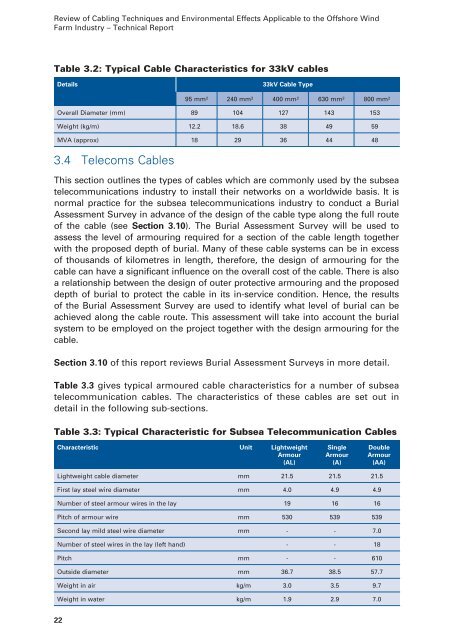Review of Cabling Techniques and Environmental Effects Applicable
Review of Cabling Techniques and Environmental Effects Applicable
Review of Cabling Techniques and Environmental Effects Applicable
Create successful ePaper yourself
Turn your PDF publications into a flip-book with our unique Google optimized e-Paper software.
<strong>Review</strong> <strong>of</strong> <strong>Cabling</strong> <strong>Techniques</strong> <strong>and</strong> <strong>Environmental</strong> <strong>Effects</strong> <strong>Applicable</strong> to the Offshore Wind<br />
Farm Industry – Technical Report<br />
Table 3.2: Typical Cable Characteristics for 33kV cables<br />
Details 33kV Cable Type<br />
22<br />
95 mm² 240 mm² 400 mm² 630 mm² 800 mm²<br />
Overall Diameter (mm) 89 104 127 143 153<br />
Weight (kg/m) 12.2 18.6 38 49 59<br />
MVA (approx) 18 29 36 44 48<br />
3.4 Telecoms Cables<br />
This section outlines the types <strong>of</strong> cables which are commonly used by the subsea<br />
telecommunications industry to install their networks on a worldwide basis. It is<br />
normal practice for the subsea telecommunications industry to conduct a Burial<br />
Assessment Survey in advance <strong>of</strong> the design <strong>of</strong> the cable type along the full route<br />
<strong>of</strong> the cable (see Section 3.10). The Burial Assessment Survey will be used to<br />
assess the level <strong>of</strong> armouring required for a section <strong>of</strong> the cable length together<br />
with the proposed depth <strong>of</strong> burial. Many <strong>of</strong> these cable systems can be in excess<br />
<strong>of</strong> thous<strong>and</strong>s <strong>of</strong> kilometres in length, therefore, the design <strong>of</strong> armouring for the<br />
cable can have a significant influence on the overall cost <strong>of</strong> the cable. There is also<br />
a relationship between the design <strong>of</strong> outer protective armouring <strong>and</strong> the proposed<br />
depth <strong>of</strong> burial to protect the cable in its in-service condition. Hence, the results<br />
<strong>of</strong> the Burial Assessment Survey are used to identify what level <strong>of</strong> burial can be<br />
achieved along the cable route. This assessment will take into account the burial<br />
system to be employed on the project together with the design armouring for the<br />
cable.<br />
Section 3.10 <strong>of</strong> this report reviews Burial Assessment Surveys in more detail.<br />
Table 3.3 gives typical armoured cable characteristics for a number <strong>of</strong> subsea<br />
telecommunication cables. The characteristics <strong>of</strong> these cables are set out in<br />
detail in the following sub-sections.<br />
Table 3.3: Typical Characteristic for Subsea Telecommunication Cables<br />
Characteristic Unit Lightweight<br />
Armour<br />
(AL)<br />
Single<br />
Armour<br />
(A)<br />
Double<br />
Armour<br />
(AA)<br />
Lightweight cable diameter mm 21.5 21.5 21.5<br />
First lay steel wire diameter mm 4.0 4.9 4.9<br />
Number <strong>of</strong> steel armour wires in the lay 19 16 16<br />
Pitch <strong>of</strong> armour wire mm 530 539 539<br />
Second lay mild steel wire diameter mm - - 7.0<br />
Number <strong>of</strong> steel wires in the lay (left h<strong>and</strong>) - - 18<br />
Pitch mm - - 610<br />
Outside diameter mm 36.7 38.5 57.7<br />
Weight in air kg/m 3.0 3.5 9.7<br />
Weight in water kg/m 1.9 2.9 7.0
















